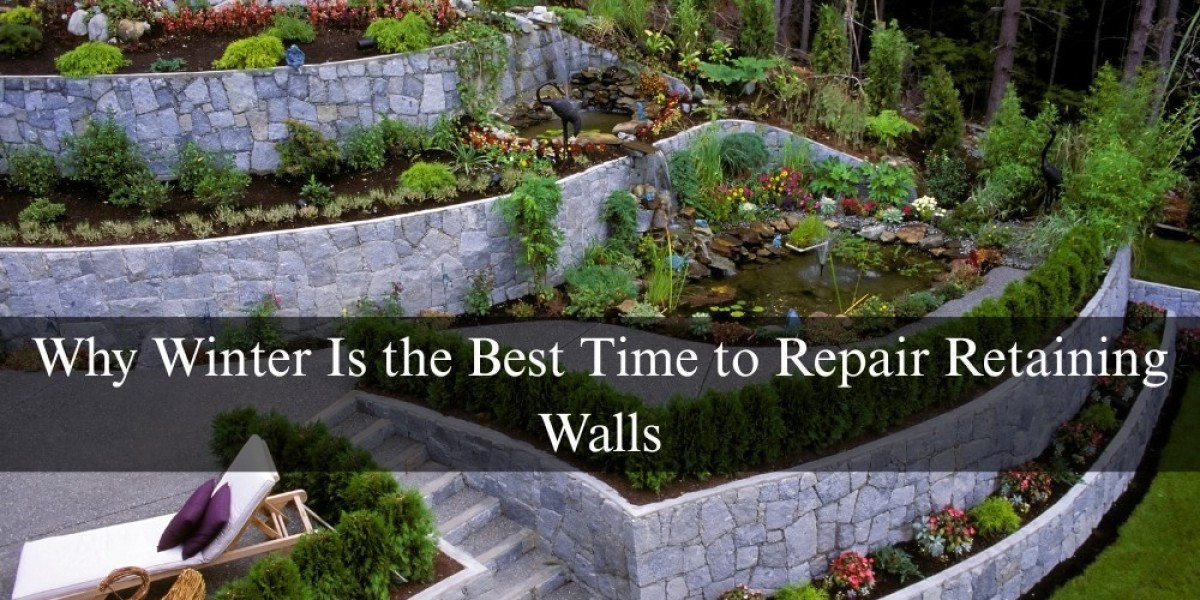You might not think of winter as the best season for outdoor work, but when it comes to retaining wall repairs, it’s often the smartest time to act. Whether you're dealing with old timber sleepers bowing under pressure or concrete blocks showing early signs of failure, winter conditions can reveal more than just cold mornings — they expose the real stress points in your garden structures.
I found this out firsthand. A few years back, after some heavy July rain, I noticed a sag behind my veggie patch. I brushed it off, thinking it could wait till spring. But by the time September rolled around, the wall had cracked, and the cost to repair it had doubled. That mistake taught me that waiting for the weather to warm up isn’t always wise.
Hiring a retaining wall specialist during winter not only gives you better scheduling availability, but it can also prevent minor wall issues from turning into major structural problems.
What makes winter the ideal time for wall repairs?
Unlike the assumptions many of us make about “waiting for dry weather,” winter often provides the perfect window to assess — and address — foundational issues in your landscape.
Here’s why:
Soil is saturated, revealing drainage issues
Reduced plant growth gives clearer access to the wall zones
Cooler weather is easier for tradespeople to work in
Faster scheduling due to seasonal contractor availability
Contractors are usually less booked out in winter, making it easier to schedule repairs. And ironically, cold weather can be helpful — it slows down rapid soil movement, giving repair work a stable base.
Signs your wall won’t survive another season
If you’re not sure what to look for, consider researching the signs of retaining wall failure. Some issues you might dismiss as surface cracks could be early warnings of movement, drainage failure, or pressure buildup.
Watch for:
Bulging or leaning sections
Soil is leaking through the wall joints
Drainage holes blocked or missing
Cracking, especially near ends or at joins
If you’re not sure what to look for, there are excellent guides that help identify the signs of retaining wall failure — some issues you might mistake for aesthetic damage could actually be structural red flags.
I remember a job in the Northern Beaches where the owner had ignored a small lean for over a year. One morning after a rainy stretch, a full section collapsed onto the neighbour’s garden. That one patch-up turned into a complete rebuild.
Drainage is your biggest winter risk
Wet weather is when you’ll discover if your wall is functioning or failing. One of the most common winter issues is drainage pressure. When water can’t escape, it builds up behind the wall, and that’s where structural failure begins.
Good retaining wall design includes:
Filter fabric and gravel backfill
Agg drains or weep holes at the base
Sloping to redirect surface runoff
Failing to manage water is often what brings a wall down, especially during wet seasons. As outlined in state guidelines, retaining wall drainage law plays a critical role in who’s responsible for runoff, wall failure, and property damage when things go wrong.
Materials matter more than you think
If you’re repairing or rebuilding, winter is also a good time to rethink the materials you’re using. Treated pine sleepers might have looked like a bargain ten years ago, but they don’t always hold up. And while concrete blocks last longer, they still need a correct footing and drainage.
Consider these upgrades:
Galvanised steel posts instead of timber
Engineered concrete blocks with rear lip locks
Natural stone for premium aesthetics and longevity
Proper footings poured below frost depth (important in hilly regions)
Every site is different — I once worked with a property in Glenhaven that needed a tiered wall system due to slope and tree root intrusion. The homeowners didn’t know winter ground swell had pushed their lower wall forward until the top tier started leaning too.
Fix now or pay double later
Winter repairs don’t just prevent collapses — they protect your landscaping investments. Retaining walls support everything from paths and patios to veggie beds and water tanks. If one fails, it often triggers a chain reaction.
What you risk by delaying:
Erosion and soil loss
Cracked driveways or paving
Water damage to nearby structures
Tree and plant death from shifted roots
If you’re already noticing drainage issues or wall movement, now is the time to act. And if you're planning new landscaping in spring, getting your walls structurally sound now will save you a world of trouble later.
Prep now, plant later: seasonal landscaping synergy
One hidden benefit of winter wall work? It sets you up beautifully for spring planting. By sorting your structure and drainage now, your soil has time to settle, meaning garden beds will be ready for new roots once the warmer weather hits.
Spring landscaping tasks you’ll be ready for:
Planting along new walls
Installing irrigation without wall obstruction
Mulching areas that won’t shift due to repairs
Building seating, decking, or pergolas against stable walls
It’s like setting the stage before the performance. By fixing the bones of your landscape during the quieter months, you allow your spring projects to flourish without hidden problems underneath.
What winter reveals about your yard’s weak points
Winter rains don’t just test your patience — they test your structures. If your retaining wall is showing signs of waterlogging, soil movement, or blocked drains, it's trying to tell you something.
And while it's tempting to wait until the weather's better, retaining wall repairs in winter are often less disruptive than you’d expect. In fact, some experts argue it's the smartest time to do it.
If you're also dealing with sloped gardens or older installations, it’s worth brushing up on techniques for preventing landscape erosion before the next storm hits.
Wrap-up: Strong walls start with smart timing
A retaining wall isn’t just a piece of your garden — it’s part of the larger system that holds your yard together. And keeping everything in balance often starts with smarter garden maintenance for structural integrity. Good wall care supports soil stability, which in turn supports healthier lawns, plants, and even property value over time.








